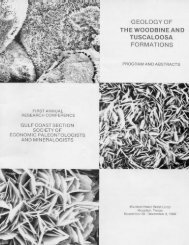Petroleum Systems of Deep-Water Basins - Gulf Coast Section SEPM
Petroleum Systems of Deep-Water Basins - Gulf Coast Section SEPM
Petroleum Systems of Deep-Water Basins - Gulf Coast Section SEPM
You also want an ePaper? Increase the reach of your titles
YUMPU automatically turns print PDFs into web optimized ePapers that Google loves.
On the Importance <strong>of</strong> Understanding Why<br />
<strong>Deep</strong> <strong>Water</strong> is <strong>Deep</strong>—a West Shetland Perspective<br />
Robert J. Hooper<br />
Conoco (U.K.) Limited<br />
Rubislaw House, Anderson Drive<br />
Aberdeen AB15 6FZ<br />
United Kingdom<br />
e-mail: Robert.Hooper@conoco.com<br />
Ian Walker<br />
Conoco (U.K.) Limited<br />
Rubislaw House, Anderson Drive<br />
Aberdeen AB15 6FZ<br />
United Kingdom<br />
Abstract<br />
Considerable crustal stretching is required to create a basin that has water depths in excess <strong>of</strong> 500m. The character,<br />
magnitude, and timing <strong>of</strong> crustal stretching has important implications for the petroleum system particularly with<br />
respect to basin structuring, heat flow and source-rock distribution, quality, and maturity. Nowhere does understanding<br />
the crustal-stretching history have more importance than in deep water basins, such as the West Shetland basinsystem,<br />
where the source rocks were deposited before the main rift-events.<br />
One <strong>of</strong> our challenges in the West Shetland basin-system has been to produce a viable tectonic model that can<br />
explain the apparent incompatibility between the present-day bathymetry and the observed basin architecture. The<br />
Faeroe-Shetland Channel is a prominent northeast-southwest trending bathymetric trough situated between the Shetland<br />
and Faeroe islands. <strong>Water</strong> depths in the axis <strong>of</strong> the channel are in excess <strong>of</strong> 1700 m. The form <strong>of</strong> the channel and<br />
the underlying geology <strong>of</strong> the Faeroe-Shetland basin system are shown in. The crust under the channel is significantly<br />
thinned the computed depth to Moho being as high as -15 km. The bathymetric low and its corresponding Moho high<br />
are, however, significantly <strong>of</strong>fset with respect to the main depositional axis <strong>of</strong> the Faeroe-Shetland basin system. The<br />
depth to top basement in the axis <strong>of</strong> the basin system is as low as -13 km. The combined Cretaceous and Paleocene<br />
section in the axis <strong>of</strong> the basin is over 10 km. This section thins dramatically towards the high ridges that frame the<br />
basin where total thickness <strong>of</strong> Cretaceous and Paleocene rocks can approach 0 km.<br />
The Faeroe-Shetland basin system was at or very close to sea level at the end <strong>of</strong> the Paleocene as evidenced by<br />
subaerial lavas in the Upper Series <strong>of</strong> the Faeroe Plateau basalts and marginal marine rocks <strong>of</strong> the earliest Eocene<br />
Balder Formation. The prominent bathymetric trough—Faeroe-Shetland channel—is a post-Paleocene feature. It is<br />
somewhat <strong>of</strong> a paradox, therefore, that there are no recognisable post-Paleocene faults <strong>of</strong> a magnitude to create a<br />
trough that has water depths in excess <strong>of</strong> 1700 m or to generate crustal thinning to a point at which the Moho is now<br />
at only -15 km. Stretching <strong>of</strong> the lithosphere under the trough is markedly heterogeneous—extension in the upper<br />
crust is significantly lower than the observed extension in the lower crust and mantle lithosphere.<br />
Anomalous subsidence patterns and heterogeneous lithospheric extension are common observations at continental<br />
margins. Depth-dependent stretching and the associated process <strong>of</strong> mantle-exhumation are known to occur at continental<br />
margins in association with sea floor spreading. The Faeroe-Shetland channel has developed after the opening<br />
<strong>of</strong> the North Atlantic. It would be tempting to speculate that depth-dependent stretching, in association with the opening<br />
<strong>of</strong> the North Atlantic, created the Faeroe-Shetland Channel. The trough is, however, linear and at a high angle to<br />
the continent-ocean transition zone to the east <strong>of</strong> the Faeroe Islands. For depth dependent stretching to have caused<br />
the observed anomalous subsidence, there must have been selective migration <strong>of</strong> mantle lithosphere and lower crust<br />
from beneath the channel during breakup northward toward the developing North Atlantic Ocean.<br />
Depth-dependent stretching is a process associated with sea-floor spreading and thus cannot explain the apparent<br />
Mesozoic heterogeneous stretching in the Faeroe-Shetland basin system. “Traditional” methods <strong>of</strong> basin reconstruction<br />
(flexural unloading and decompaction; removal <strong>of</strong> fault-heaves) using “traditional” interpretations <strong>of</strong> the basin<br />
33

















